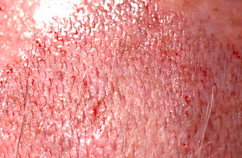Parallel vs. Perpendicular Sites in Hair Restoration
There has been a controversy over the past few years regarding the best method to make a recipient site. There are basically two ways to make recipient sites parallel (also known as sagittal) and perpendicular (also known as lateral slits, or coronal). A recipient site, as a reminder, is the “hole”, or slit, that is made by the surgeon into which the graft preparation team will insert the hair graft. Although I use both parallel and perpendicular sites during a given procedure, my overwhelming preference is to create parallel sites. In this article I will explain the pros and cons of parallel and perpendicular sites and then explain why I prefer parallel sites.

This photograph shows parallel sites with the front of the head corresponding with the top of the photograph.
Before we start, we need to clarify what a parallel and a perpendicular site really are. A parallel site, as the name implies, runs parallel to how the hair shaft grows. If you are facing a person’s head, the site is made running front to back, i.e., it is longer from front to back than from side to side. A perpendicular site is a recipient site that runs principally side-to-side of the patient’s head. The proponents of perpendicular sites argue that these types of site are preferred because the hair grafts will not tilt upward after placement so the front to back angle of the hair shaft will not be changed. That is the overriding concern for doing a perpendicular approach. That is why I oftentimes use it for the temple area or the eyebrow area where the angle has to be almost entirely flat to the scalp. However, I have found for the central head, a host of problems with the lateral slit or perpendicular method.
Perpendicular sites in my opinion do not control the angle of the site that much better when you are using very fine instruments that are matched very well for graft-to-site fit. When I use an 18 or 19 gauge needle to make my sites, the sites are so small that the grafts do not have much wiggle room to change angles. In addition, I ensure that the grafts truly fit the site before starting to make my sites so that they don’t move. Also, I make my sites at a lower angle to accommodate for even a 5 or 10 degree angle change upward, which again is unlikely and even if there is such a slight change it would not impact the final result.
Here now are the reasons why I do not perform perpendicular sites in the majority of my hair transplant procedures. Perpendicular sites run counter to the way that the hair grows. When trimming grafts, it is very unnatural to cut them this way because that is not how hair naturally grows. In addition, when making the sites for anyone who has natural hair already present or previously grafted hairs, it is very easy to transect the other surrounding hairs and destroy them when making perpendicular recipient sites. This is the number one reason why I do not make perpendicular sites. In addition, perpendicular sites run perpendicular to blood flow, meaning that the blood supply can also be compromised. To me preserving blood supply for optimal hair growth is important. For these reasons, I truly believe parallel, or sagittal, sites are much preferred for 90 to 95% of my hair-transplant work with the exceptions mentioned above.
Samuel M. Lam, MD, FACS is a board certified hair restoration surgeon in Dallas, Texas. To learn more about Dr Lam’s hair restoration procedures please visit our website hairtx.com or call 972-312-8105 to schedule a consultation.




